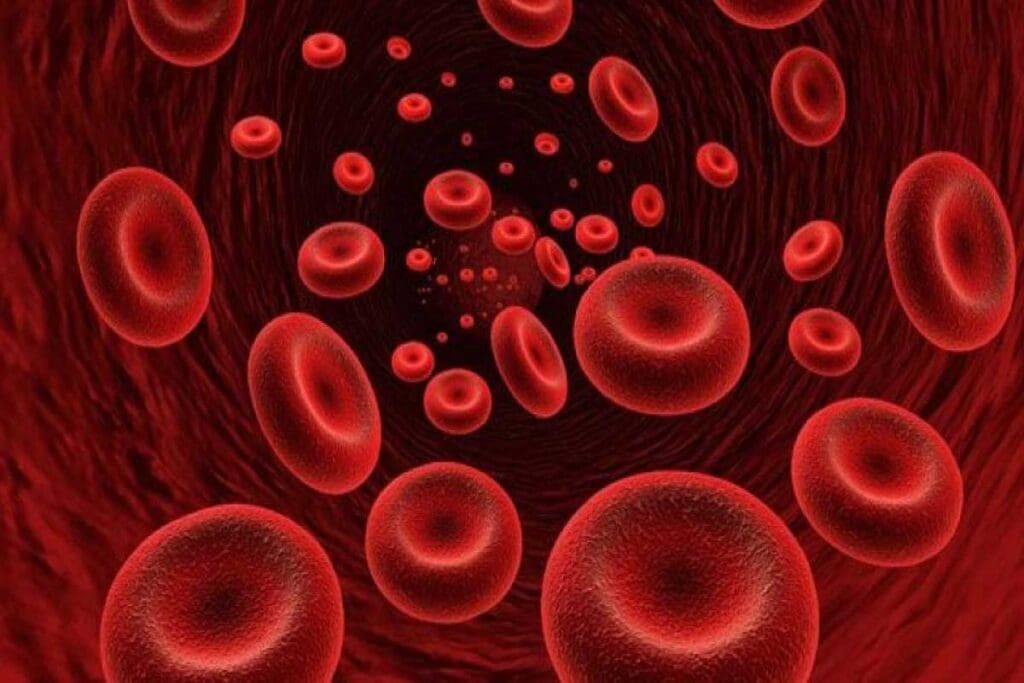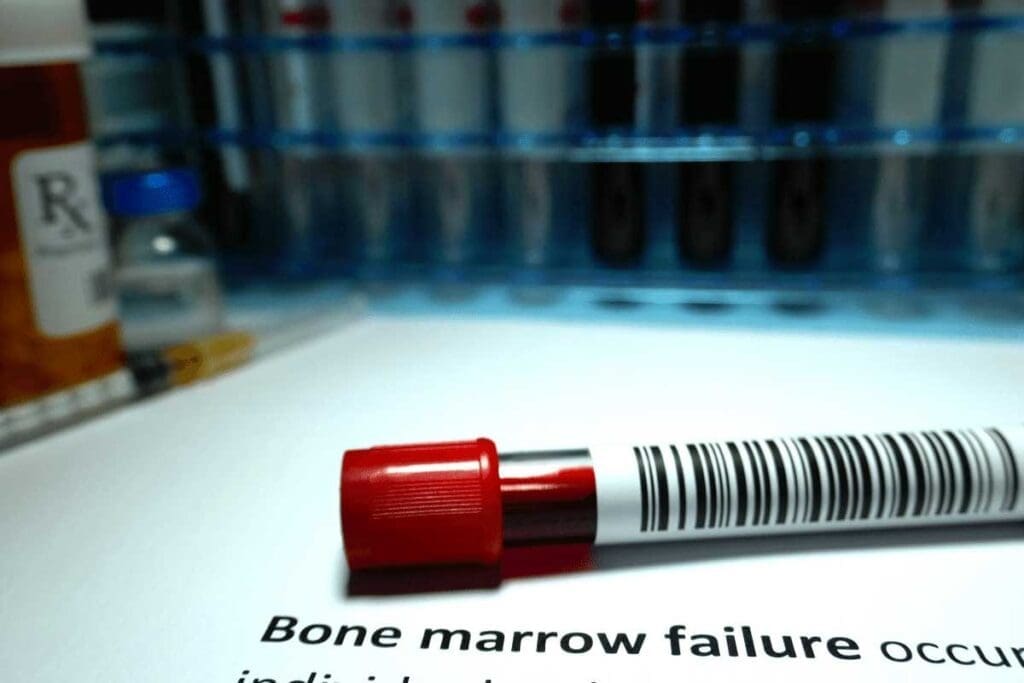Last Updated on November 17, 2025 by Ugurkan Demir

At LivHospital, we know how serious aplastic anemia is. It’s a rare but dangerous condition where the bone marrow doesn’t make enough blood cells. This can cause tiredness, infections, and bleeding. Discover effective aplastic anemia treatments and learn what causes bone marrow failure in this detailed medical guide.
We focus on giving the best care to help patients live longer. Our approach includes different treatment options. These include hematopoietic stem cell transplantation and using medicines to fight off the disease. We aim to fix the bone marrow failure problem.

Aplastic anemia is a rare and serious condition. It happens when the bone marrow can’t make enough blood cells. This leads to a lack of red blood cells, white blood cells, and platelets.
Aplastic anemia is when the bone marrow can’t make blood cells fast enough. This results in fewer red blood cells, white blood cells, and platelets. It can be caused by toxins, certain medicines, and viruses.
In aplastic anemia, the bone marrow can’t make enough blood cells. The bone marrow is key for making red blood cells, white blood cells, and platelets. Without enough, health problems arise.
Aplastic anemia is different from other anemias because it affects all blood cells. Doctors use blood tests and bone marrow biopsies to diagnose it. This helps understand how much the bone marrow is failing.
| Characteristics | Aplastic Anemia | Other Types of Anemia |
| Blood Cells Affected | Red blood cells, white blood cells, and platelets | Primarily red blood cells |
| Cause | Bone marrow failure | Various, including iron deficiency, vitamin deficiency |
| Diagnostic Approach | Blood tests and bone marrow biopsy | Blood tests, sometimes bone marrow biopsy |
It’s important to know the differences between aplastic anemia and other anemias. This helps doctors find the right treatment. By understanding the condition, they can help patients better.

Understanding why bone marrow fails is key to tackling aplastic anemia. This condition makes it hard for the bone marrow to make blood cells. This leads to serious health issues. The causes can be either inherited or acquired, as studies show (NCBI Bookshelf).
One main reason for bone marrow failure in aplastic anemia is the immune system attacking its own stem cells. This makes the bone marrow unable to make enough blood cells. The bone marrow’s function is severely harmed.
“The immune system’s role in aplastic anemia is complex, involving both cellular and humoral immunity,” as noted in medical literature. The destruction of hematopoietic stem cells is a critical factor in the development of the condition, highlighting the need for targeted therapeutic approaches.
Environmental factors and toxic exposures also cause bone marrow failure in aplastic anemia. Exposure to harmful chemicals, like pesticides and solvents, increases the risk. Radiation can also damage the bone marrow, leading to aplastic anemia.
Genetic factors and inherited conditions also contribute to aplastic anemia. Certain genetic disorders, like Fanconi anemia, raise the risk of bone marrow failure. These conditions often involve mutations that affect blood cell production.
The presence of genetic factors makes diagnosing and treating aplastic anemia more complex. It highlights the importance of genetic testing and counseling for families affected.
In many cases, the cause of aplastic anemia is unknown, known as idiopathic aplastic anemia. Diagnosis is based on symptoms and bone marrow biopsy, without a clear cause.
Dealing with idiopathic aplastic anemia is challenging. Treatment plans often rely on knowing the cause. Research aims to find new ways to treat these cases.
It’s important to know the signs of aplastic anemia early. This condition happens when the bone marrow can’t make blood cells. This leads to various symptoms.
People with aplastic anemia often feel tired, get sick easily, and bleed a lot. They get tired because their bone marrow doesn’t make enough red blood cells. They get sick because their bone marrow doesn’t make enough white blood cells. They bleed because their bone marrow doesn’t make enough platelets.
The severity of these symptoms can vary. Some people might not show any symptoms at all. Others might have symptoms that are very serious and could be life-threatening.
To diagnose aplastic anemia, doctors use a few methods. They look at the patient’s symptoms, do blood tests, and examine the bone marrow. The criteria for diagnosis include:
Doctors use blood tests to see how low the blood counts are. They also do a bone marrow biopsy to confirm the diagnosis and check the bone marrow’s health.
The severity of aplastic anemia is based on how low the blood counts are and how healthy the bone marrow is. The Camitta criteria are used to classify the disease’s severity.
| Severity | Criteria |
| Severe | ANC |
| Very Severe | ANC |
| Non-Severe | Not meeting criteria for severe or very severe aplastic anemia |
The severity of the disease helps decide the treatment. More intense treatments are used for those with severe or very severe aplastic anemia.
There are seven main ways to treat aplastic anemia, each with its own approach. These treatments aim to tackle the disease’s complexities. They offer patients options that fit their specific needs.
The severity of aplastic anemia is key in choosing a treatment. For severe cases, treatments like hematopoietic stem cell transplantation might be needed. Less severe cases might be treated with immunosuppressive therapy. A study on NCBI Bookshelf shows that treatment choices depend on how severe the disease is.
When picking a treatment, we look at several things. These include the patient’s health, any other health issues they have, and the details of their aplastic anemia.
Age is also important in choosing a treatment. Younger patients might get hematopoietic stem cell transplantation. Older patients might get other treatments because of the risks of transplant. Having a matched donor is also key for better transplant outcomes.
“The choice of treatment for aplastic anemia depends on several factors, including the patient’s age, the severity of the disease, and the availability of a suitable donor.”
Knowing what to expect and survival rates is vital for making choices. For example, successful hematopoietic stem cell transplantation can greatly improve a patient’s condition. Some studies show survival rates similar to the general population.
| Treatment Approach | Expected Outcome | Survival Rate |
| Hematopoietic Stem Cell Transplantation | Potential cure | 80-90% |
| Immunosuppressive Therapy | Improved blood counts | 70-80% |
| Supportive Care | Management of symptoms | Varies |
By looking at these factors and the treatment options, we can create a treatment plan that meets each patient’s needs.
Hematopoietic stem cell transplantation is now seen as the top treatment for aplastic anemia. It has changed how we manage the disease, giving patients a chance for a cure.
Allogeneic hematopoietic stem cell transplantation (HSCT) can cure aplastic anemia by fixing the stem cell pool. This method has shown great promise, mainly for younger patients.
Having a matched sibling donor is key to a successful HSCT. Matched sibling donor transplants lead to better survival rates and fewer disease relapses.
The benefits of these transplants include:
The transplant process includes choosing a donor, harvesting stem cells, preparing the patient, and infusing stem cells. Proper preparation is key to avoid complications and ensure success.
We assess the patient’s health and prepare them with a conditioning regimen. This regimen uses immunosuppressive therapy to clear the old bone marrow and prevent the body from rejecting the new stem cells.
After the transplant, careful monitoring is essential to catch and manage any complications. Regular check-ups help ensure a smooth recovery.
Some possible issues with HSCT include:
We closely watch over patients to manage these risks and provide full care during the transplant.
The immune system plays a big role in bone marrow failure in aplastic anemia. Immunosuppressive therapy is a key treatment. It helps when the immune system attacks the body’s own stem cells, causing aplastic anemia.
The triple IST protocol uses Antithymocyte Globulin (ATG), cyclosporine, and eltrombopag to fight the immune system’s attack on bone marrow cells.
ATG reduces T-cells, which harm stem cells. Cyclosporine stops T-cells from getting active. Eltrombopag helps make more blood cells, helping the bone marrow recover.
The triple IST protocol is given carefully. ATG is given intravenously for a few days. Cyclosporine is taken orally for months to a year or more, based on how well the patient does. Eltrombopag is taken orally, with its dose changed based on blood cell counts.
Checking how well the treatment works involves watching blood cell counts and bone marrow biopsies. Follow-up care is key. It lets doctors adjust the treatment and handle any side effects or problems.
For those without a matched sibling donor, alternative donor transplants are a good option. These transplants are key in treating aplastic anemia. They give hope to those without a traditional donor.
Unrelated donor transplantation uses a donor who isn’t a biological relative but has the right HLA type. Thanks to better HLA typing and immunosuppressive treatments, this method is now more effective. Haploidentical transplantation uses a half-matched family member. It’s a good option for those without a fully matched donor.
“The use of alternative donors has expanded the pool of possible donors for aplastic anemia patients,” studies show. This is a big step forward for those with few treatment options before.
Cord blood transplants are another choice for those without a matched sibling donor. Cord blood is easy to find, and HLA matching is less strict. But, cord blood units often have fewer cells, which can be a problem.
Often, using two cord blood units or mixing it with other stem cells is needed. This helps overcome the cell dose issue.
The treatment for aplastic anemia is always getting better, thanks to new therapies and trials. These include new immunosuppressive drugs, gene therapy, and ways to boost blood cell production. Participating in clinical trials lets patients try new treatments not yet available.
As we learn more about treating aplastic anemia, it’s important for patients and doctors to keep up with the latest. New treatments could greatly improve life for those with this condition.
Supportive care is key for patients with aplastic anemia. It helps manage complications from bone marrow failure. This care includes various strategies to reduce risks and consequences.
Blood transfusions are vital for aplastic anemia patients. They help fight anemia and prevent bleeding by boosting red blood cell and platelet counts.
Regular transfusions can greatly improve patients’ lives. They reduce fatigue and other symptoms caused by low blood cell counts.
| Type of Transfusion | Purpose | Benefits |
| Red Blood Cell Transfusion | To increase red blood cell count and alleviate anemia | Reduces fatigue, improves oxygen delivery to tissues |
| Platelet Transfusion | To prevent or treat bleeding due to low platelet count | Reduces risk of hemorrhage, manages bleeding episodes |
Patients with aplastic anemia face a higher risk of infections. It’s important to prevent infections to keep them safe.
Growth factors help stimulate bone marrow to produce more blood cells. While their use is limited in aplastic anemia, they can be helpful in some cases.
Other medications may be used to manage specific complications or symptoms. For example, antifungal or antiviral medications to treat infections.
Bleeding is a big risk for patients with aplastic anemia, mainly those with low platelet counts. To avoid bleeding, patients should avoid activities that could cause injury. They should use soft-bristled toothbrushes and be careful when shaving.
If there’s active bleeding, quick medical help is needed. Treatment might include platelet transfusions and other supportive measures.
By understanding and using these supportive care measures, patients with aplastic anemia can manage their condition better. This improves their quality of life.
Aplastic anemia is a complex condition where the bone marrow fails to produce blood cells. This leads to various complications. Thanks to better care, survival rates have gone up. Research is also making treatments more effective.
Managing aplastic anemia means having a detailed plan. This includes regular check-ups and changing treatments when needed. We’ve looked at different treatments like stem cell transplants and supportive care.
Looking ahead, we aim to improve treatment results for aplastic anemia. New research on therapies and alternative donor transplants gives patients hope. These efforts are ongoing.
As we learn more about aplastic anemia, we can better care for patients. This improves their quality of life and long-term health. Effective management needs a team effort. We’re dedicated to providing top-notch care and support worldwide.
Aplastic anemia is when the bone marrow can’t make enough blood cells. This leads to tiredness, infections, and bleeding.
Bone marrow failure can happen for many reasons. It might be because of the immune system attacking the stem cells. Or it could be due to environmental factors, genetics, or just happen on its own.
Doctors use a few ways to find out if you have aplastic anemia. They look at your health history and do tests like blood counts and bone marrow biopsies.
People with aplastic anemia often feel very tired, get sick easily, and bleed a lot. This is because their bone marrow can’t make enough blood cells.
There are a few ways to treat aplastic anemia. Doctors might suggest getting a bone marrow transplant, using medicines to calm down the immune system, or just helping manage the symptoms.
This is a treatment where they replace your damaged bone marrow with healthy stem cells from someone else. It’s like a new start for your bone marrow.
This treatment helps your bone marrow by stopping your immune system from attacking it. It lets your bone marrow start making blood cells again.
Doctors look at how bad the bone marrow failure is and if there are other problems. This helps them figure out how serious it is.
Supportive care is very important. It helps with things like getting blood transfusions, preventing infections, and making sure you don’t bleed too much.
Yes, there are new treatments and studies going on. They include new medicines and gene therapy to help with aplastic anemia.
Sometimes, aplastic anemia can be cured. This happens with treatments like bone marrow transplants or medicines. But it depends on how bad the disease is and how well you respond to treatment.
References
Subscribe to our e-newsletter to stay informed about the latest innovations in the world of health and exclusive offers!